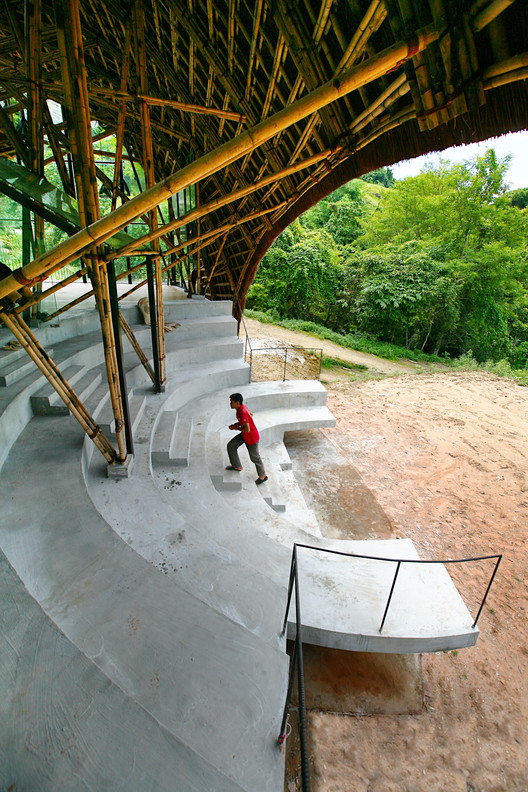Tibet Namchabawa Visitor Centre standardarchitecture
2015-10-15 20:00
架构师提供的文本描述。游客中心是继雅仑庄船坞之后,西藏第二座由标准建筑设计的建筑。位于西藏自治区东南部林芝地区一个名为白镇的小村庄。这座建筑坐落在公路上的一个斜坡上,通往雅伦子浦大峡谷深处的最后一个村庄,北面是雅伦子浦河,东面是7782米高的南沙巴瓦山。
Text description provided by the architects. The visitor centre is the second building designed by standardarchitecture in Tibet after the Yaluntzangpu Boat Terminal. It is located in a small village called Pai Town in Linzhi area, southeastern part of Tibet autonomous region. The building sits on a slope along the road leading to the last village Zhibai deep in the Grand Canyon of Yaluntzangpu, facing the Yaluntzangpu River to its north and with the 7782 meter high Mount Namchabawa at its background in the east.
Courtesy of standardarchitecture
这座1500平方米的建筑是游客欢迎中心,提供了南沙巴瓦山和雅伦庄浦大峡谷的全面信息。它也是村民们的“市中心”,也是探索峡谷的背包徒步旅行者的补给基地。因此,程序是相当复杂的。它包括接待/问讯厅、公共厕所、供应商店、网吧、医疗中心、背包客更衣室、会议室、导游和司机办公室、一个预订水的水箱和一个村庄的中央电气开关房。
The 1500 sqm building serves as a visitor welcome centre providing comprehensive information about Mount Namchabawa and Yaluntzangpu Grand Canyon. It serves also as the “town centre” for the villagers as well as the supply base for the backpack hikers exploring the canyon. Therefore the program is quite complicated. It includes a reception/information hall, public toilets, a supply store, an internet bar, a medical center, locker room for backpackers, meeting rooms, offices for tour guides and drivers, a water reservation tank and a central electrical switch house for the village.
Courtesy of standardarchitecture
Courtesy of standardarchitecture
就像从山上延伸出来的几片岩石一样,这座建筑被设想成一系列的石墙,设置在斜坡上,西面没有窗户,几乎没有规模,是自然景观中的抽象景观。从远处看,它既不隐藏自己,也不从背景中脱颖而出,成为“藏语”建筑的一部分。
Like a few slices of rock extending out of the mountain, the building is conceived as a series of stone walls set into the slope, with no windows facing the incoming road in the west, almost scale-less, an abstract landscape in the natural landscape. Looking from afar it neither hides itself, nor stands out from its background as a piece of “Tibetan” architecture.
Courtesy of standardarchitecture
从路上走到很远的地方,人们无法确定这是一座建筑物,还是一套挡土墙,甚至是山脚下的一堵“玛尼”墙。下车后,游客沿着一条由石挡土墙带领的小径向山上爬去,在那里他们找到了接待/展览厅的主要入口。大厅内灯火通明,有一扇朝北面向村庄和鸭绿浦江的观景窗。进入1米厚的石墙的第二层,游客们找到了公厕和公共行李储藏室,穿过了另一层石墙,他们找到了网吧、诊所和司机的休息室。中途,他们可以选择走“通往天堂的楼梯”到二楼的屋顶花园和会议室。水箱藏在楼梯下面,电开关室占据地下空间。
Approaching from a distance on the road, people can not be sure if this is a building or a set of retaining wall or even a “Mani” wall at the foot of the mountain. Taking off their cars, visitors follow a pathway led by a stone retaining wall up the hill, where they find the main entrance to the reception/exhibition hall. The main hall is lit by sky lights and has a view window facing north towards the village and the Yaluntzangpu River. Entering the second layer of the 1-meter-thick stone wall, visitors find the public toilets and the public luggage storage room, going further through another layer of stone wall they find the internet café, medical clinic and the drivers’ rest space. Halfway they have the choice of taking the “stair way to heaven” up to the second floor for the roof garden and the meeting rooms. The water tank is hidden beneath the stairs and the electric switch room takes the underground space.
经过短暂的休息,收集了该地区的必要信息和其他物资,并向亲友发送电子邮件,游客们再次被一条蜿蜒的石路带到村子里,然后开始探索南恰巴瓦山,然后消失在雅伦子浦山谷的无人区,持续了几天甚至几周。
After a brief rest, gathering necessary information of the area and other supplies, sending out emails to friends and relatives, visitors are again led by a zig-zag stone path way down the hill into the village, and afterwards, set foot to explore the Mount Namchabawa and disappear into the no-man-forest of the Yaluntzangpu valley for days and weeks.
Courtesy of standardarchitecture
 举报
举报
别默默的看了,快登录帮我评论一下吧!:)
注册
登录
更多评论
相关文章
-

描边风设计中,最容易犯的8种问题分析
2018年走过了四分之一,LOGO设计趋势也清晰了LOGO设计
-

描边风设计中,最容易犯的8种问题分析
2018年走过了四分之一,LOGO设计趋势也清晰了LOGO设计
-

描边风设计中,最容易犯的8种问题分析
2018年走过了四分之一,LOGO设计趋势也清晰了LOGO设计




































































































































